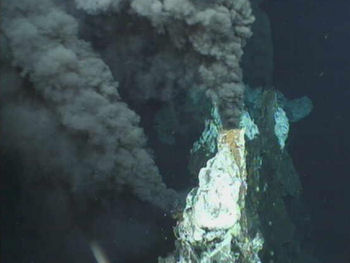Citizens of the deep
To an ecologist, the greatest apparent challenge at vents and seeps is not pressure, or temperature, or even toxicity. It is the ephemeral and island-like nature of these chemical oases. Vents occur as clusters of chimneys, called 'fields', that are just a couple of football pitches in area. But these fields are scattered tens, or even hundreds, of miles apart along chains of undersea volcanoes. Each set of vents does not last forever either. Some may keep going for centuries, but others only last for decades. They can become clogged with mineral deposits, buried by lava flows, or have their plumbing cut off by earthquakes.
When venting stops, most - if not all - of the animals at that oasis are doomed. Many species cannot simply relocate: the tubeworms at vents, for example, are glued to the rocks. And even those that can move, such as vent shrimp, are usually so dependent on the oases for sustenance that they cannot cross the deep-sea desert to the next oasis, which may be hundreds of miles away.

Yet clearly these animals must have some means of overcoming this problem, otherwise they could not persist in these habitats. For many animals, the answer seems to lie in their larval forms - the tiny early stages of their life cycle, which are often very different to the adults. Like seeds blown on the wind, these larvae may be dispersed by ocean currents. And sometimes a few may make it the tens or even hundreds of miles to another oasis, rather than falling on 'stony ground', to use a Biblical metaphor.
In the case of the tubeworms, their tiny larvae are sent out with energy stores to sustain them on their journey. The tubeworm larvae cannot feed, but they eke out their energy reserves because their metabolism ticks over very slowly in the cold deep waters away from vents. But even so, the larva of a vent tubeworm can only survive for just under forty days in the wilderness before its reserves are spent.
In contrast, the vent shrimp found on the Mid-Atlantic Ridge produce offspring that can feed while away from vents. These larvae look very different to the adult shrimp and are well-suited for making long-distance journeys in mid-water. And when they arrive at a vent, the larvae undergo a transformation to the adult form, which is well-suited for life at the vents. At first this life-cycle confused biologists, who thought the in-between stage in that transformation was a separate species of shrimp.
The feeding larvae of the vent shrimp may allow them to survive for longer and perhaps cross greater distances than the tubeworm larvae. This difference may explain part of a global jigsaw puzzle of life at vents. Different animals are found at vents in different oceans and biologists have pondered why no tubeworms have been found yet at Atlantic vents.
Vent fields on the Mid-Atlantic Ridge are spaced further apart than those in the eastern Pacific, because the Mid-Atlantic Ridge is less volcanically active. The shorter lifespan of tubeworm larvae may not be long enough to drift hundreds of miles between vent fields in the Atlantic. But vent fields are much closer together in the eastern Pacific, and deep ocean currents can sweep tubeworm larvae from vent to vent before the larvae use up their energy reserves.
Page 1: A golden age of exploration
Page 2: Secret ingredients of life at vents
Page 3: Life finds a way
Page 4: Island-hopping in the abyss
Page 5: Twilight of the Gods
Science
Find out more about the Cayman Trough, undersea volcanoes, deep-sea vents,
and the inhabitants of the abyss.
What are we investigating?


